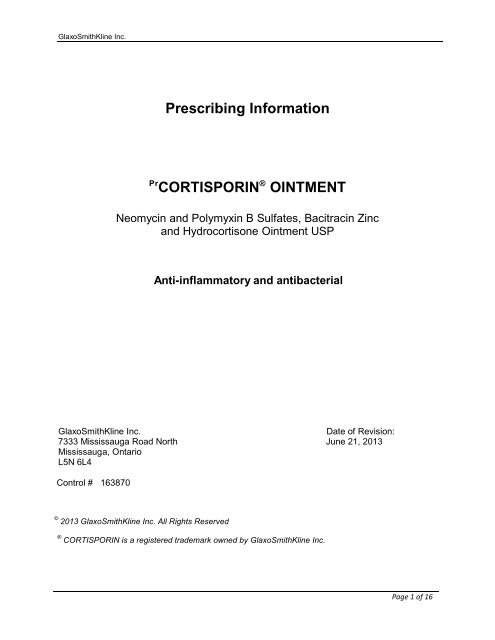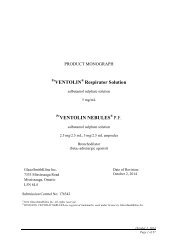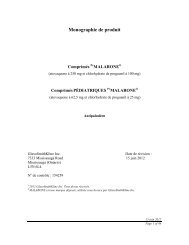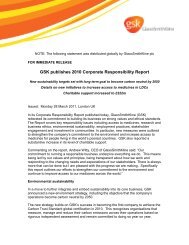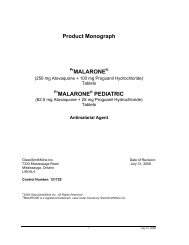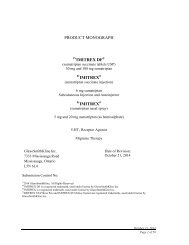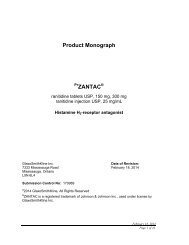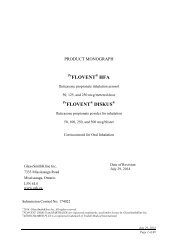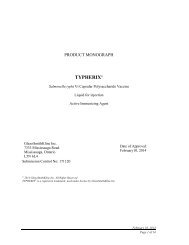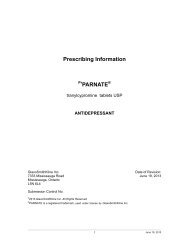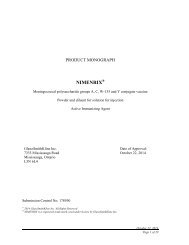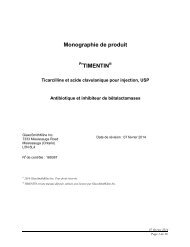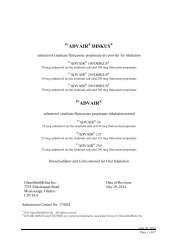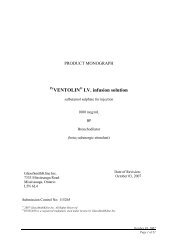Cortisporin Ointment - GlaxoSmithKline
Cortisporin Ointment - GlaxoSmithKline
Cortisporin Ointment - GlaxoSmithKline
You also want an ePaper? Increase the reach of your titles
YUMPU automatically turns print PDFs into web optimized ePapers that Google loves.
<strong>GlaxoSmithKline</strong> Inc.<br />
Prescribing Information<br />
Pr<br />
CORTISPORIN ® OINTMENT<br />
Neomycin and Polymyxin B Sulfates, Bacitracin Zinc<br />
and Hydrocortisone <strong>Ointment</strong> USP<br />
Anti-inflammatory and antibacterial<br />
<strong>GlaxoSmithKline</strong> Inc.<br />
Date of Revision:<br />
7333 Mississauga Road North June 21, 2013<br />
Mississauga, Ontario<br />
L5N 6L4<br />
Control # 163870<br />
© 2013 <strong>GlaxoSmithKline</strong> Inc. All Rights Reserved<br />
® CORTISPORIN is a registered trademark owned by <strong>GlaxoSmithKline</strong> Inc.<br />
Page 1 of 16
<strong>GlaxoSmithKline</strong> Inc.<br />
Prescribing Information<br />
Pr CORTISPORIN ®<br />
Neomycin and Polymyxin B Sulfates,<br />
Bacitracin Zinc and Hydrocortisone <strong>Ointment</strong> USP<br />
Anti-inflammatory and antibacterial<br />
Clinical Pharmacology<br />
Corticosteroids suppress the inflammatory response to a variety of agents and they may delay<br />
healing. Since corticosteroids may inhibit the body’s defense mechanism against infection, a<br />
concomitant antimicrobial drug may be used when this inhibition is considered to be clinically<br />
significant in a particular case.<br />
The anti-infective components in the combination are included to provide action against specific<br />
organisms susceptible to them. Polymyxin B sulfate and neomycin sulfate together are<br />
considered active against the following microorganisms: Staphylococcus aureus, Escherichia<br />
coli, Haemophilus influenzae, Klebsiella-Enterobacter species, Neisseria species and<br />
Pseudomonas aeruginosa. This product does not provide adequate coverage against Serratia<br />
marcescens and streptococci, including Streptococcus pneumoniae.<br />
When used topically, bacitracin zinc, polymyxin B sulfate and neomycin sulfate are rarely<br />
irritating and are not absorbed systemically in significant amounts through intact skin or<br />
mucous membrane, but the possibility of significant absorption exists when extensive raw<br />
Page 2 of 16
<strong>GlaxoSmithKline</strong> Inc.<br />
areas are being treated. The incidence of skin sensitization to this combination has been<br />
shown to be low on normal skin. Since these antibiotics are seldom used systemically, the<br />
patient is spared sensitization to those antibiotics which might later be required systemically.<br />
Hydrocortisone is partially absorbed through intact skin and this absorption is enhanced when<br />
the skin is broken or occluded.<br />
The relative potency of corticosteroids depends on the molecular structure,<br />
concentration, and release from the vehicle.<br />
Indications and Clinical Use<br />
CORTISPORIN ® (Neomycin and Polymyxin B Sulfates, Bacitracin Zinc and<br />
Hydrocortisone <strong>Ointment</strong> USP) <strong>Ointment</strong> is indicated for the treatment of skin infections and<br />
inflammation.<br />
Not for use in the eyes.<br />
Contraindications<br />
CORTISPORIN ® (Neomycin and Polymyxin B Sulfates, Bacitracin Zinc and<br />
Hydrocortisone <strong>Ointment</strong> USP) <strong>Ointment</strong> should not be used to treat otitis externa in the<br />
presence of a perforated tympanic membrane because of the risk of ototoxicity.<br />
The use of CORTISPORIN ® <strong>Ointment</strong> is contraindicated in patients who have<br />
demonstrated allergic hypersensitivity to any of the components of the preparation or to crosssensitizing<br />
substances such as aminoglycosides and other related antibiotics.<br />
Page 3 of 16
<strong>GlaxoSmithKline</strong> Inc.<br />
The presence of pre-existing nerve deafness is a contra-indication to the use of<br />
CORTISPORIN ®<br />
<strong>Ointment</strong> in circumstances in which significant systemic<br />
absorption could occur.<br />
Due to the known ototoxic and nephrotoxic potential of neomycin sulfate, the use of<br />
CORTISPORIN ® in large quantities or on large areas for prolonged periods<br />
of time is not recommended in circumstances where significant systemic absorption may<br />
occur.<br />
Viral, tuberculous, primary bacterial and fungal infections of the skin are contra-<br />
indications to the use of CORTISPORIN ® <strong>Ointment</strong>.<br />
A possibility of increased neomycin absorption exists in very young children, thus<br />
CORTISPORIN ® <strong>Ointment</strong> is not recommended for use in neonates and infants<br />
(up to 2 years). In neonates and infants, absorption by immature skin may be enhanced and<br />
renal function may be immature.<br />
Warnings<br />
The concurrent use of other aminoglycoside antibiotics is not recommended in circumstances<br />
where significant systemic absorption of neomycin sulfate following topical application could<br />
occur.<br />
Neomycin sulfate may cause cutaneous sensitization. A precise incidence of hypersensitivity<br />
reactions (primarily skin rash) due to topical neomycin is not known.<br />
Page 4 of 16
<strong>GlaxoSmithKline</strong> Inc.<br />
When using neomycin-containing products to control secondary infection in the chronic<br />
dermatoses, such as chronic otitis externa or stasis dermatitis, it should be borne in mind that<br />
the skin in these conditions is more liable than is normal skin to become sensitized to many<br />
substances including neomycin.<br />
The manifestation of sensitization to neomycin is usually a low-grade reddening with swelling,<br />
dry scaling and itching; it may be manifested simply as a failure to heal. Periodic examination<br />
for such signs is advisable, and the patient should be told to discontinue the product if they are<br />
observed. These symptoms regress quickly on withdrawing the medication. Neomycincontaining<br />
applications should be avoided for the patient thereafter.<br />
Following significant systemic absorption: aminoglycosides such as neomycin can cause<br />
irreversible ototoxicity; neomycin sulfate, polymyxin B sulfate and bacitracin zinc have<br />
nephrotoxic potential; polymyxin B sulfate has neurotoxic potential.<br />
Gastrointestinal<br />
Clostridium difficile-associated disease:<br />
Clostridium difficile-associated disease (CDAD) has been reported with use of many<br />
antibacterial agents. CDAD may range in severity from mild diarrhea to fatal colitis. It is<br />
important to consider this diagnosis in patients who present with diarrhea, or symptoms of<br />
colitis, pseudomembranous colitis, toxic megacolon, or perforation of colon subsequent to the<br />
administration of any antibacterial agent. CDAD has been reported to occur over 2 months<br />
after the administration of antibacterial agents.<br />
Treatment with antibacterial agents may alter the normal flora of the colon and may permit<br />
overgrowth of Clostridium difficile. Clostridium difficile produces toxins A and B, which<br />
contribute to the development of CDAD. CDAD may cause significant morbidity and mortality.<br />
CDAD can be refractory to antimicrobial therapy.<br />
Page 5 of 16
<strong>GlaxoSmithKline</strong> Inc.<br />
If the diagnosis of CDAD is suspected or confirmed, appropriate therapeutic measures should<br />
be initiated. Mild cases of CDAD usually respond to discontinuation of antibacterial agents not<br />
directed against Clostridium difficile. In moderate to severe cases, consideration should be<br />
given to management with fluids and electrolytes, protein supplementation, and treatment with<br />
an antibacterial agent clinically effective against Clostridium difficile. Surgical evaluation should<br />
be instituted as clinically indicated, as surgical intervention may be required in certain severe<br />
cases<br />
Precautions<br />
General<br />
As with any antibiotic preparation, prolonged use may result in the overgrowth of nonsusceptible<br />
organisms, including fungi. The possibility of persistent fungal infections of the<br />
cornea and ear should be considered after prolonged steroid dosing. Appropriate measures<br />
should be taken if this occurs.<br />
The use of CORTISPORIN ® (Neomycin and Polymyxin B Sulfates, Bacitracin<br />
Zinc and Hydrocortisone <strong>Ointment</strong> USP) <strong>Ointment</strong> should not be continued for more than 7<br />
days in the absence of any clinical improvement. If the infection is not improved after one<br />
week, cultures and susceptibility tests should be repeated to verify the identity of the organism<br />
and to determine whether therapy should be changed.<br />
Allergic cross-reactions may occur which could prevent the use of any or all of the<br />
aminoglycoside antibiotics for the treatment of future infections.<br />
Hydrocortisone may mask the allergic effects produced by any component of<br />
CORTISPORIN ® <strong>Ointment</strong>.<br />
Page 6 of 16
<strong>GlaxoSmithKline</strong> Inc.<br />
Signs and symptoms of exogenous hyperadrenocorticism, including adrenal suppression, can<br />
occur with the use of topical corticosteroids. Systemic absorption of topically applied steroids<br />
will be increased if extensive body suface areas are treated or if occlusive dressings are used.<br />
Under these circumstances, suitable precautions should be taken when long-term use is<br />
anticipated.<br />
Avoid introduction of CORTISPORIN ® ointment into the eye. If CORTISPORIN ® ointment is<br />
accidentally introduced into the eye, the eye should be rinsed thoroughly with cold water.<br />
CORTISPORIN ® ointment should be kept out of reach of children.<br />
Use in the Elderly<br />
CORTISPORIN ® <strong>Ointment</strong> is suitable for use in elderly patients. Caution should be exercised<br />
in cases where a decrease in renal function exists and significant systemic absorption of<br />
neomycin sulfate may occur (see Dosage and Administration section).<br />
Use in Children<br />
CORTISPORIN ® <strong>Ointment</strong> is suitable for use in children (2 years and over) at the same dose<br />
as adults. A possibility of increased absorption exists in very young children, thus<br />
CORTISPORIN ® <strong>Ointment</strong> is not recommended for use in neonates and infants (
<strong>GlaxoSmithKline</strong> Inc.<br />
Use in Pregnancy<br />
There is little information to demonstrate the possible effect of topically applied neomycin in<br />
pregnancy. However, neomycin present in maternal blood can cross the placenta and may<br />
give rise to a theoretical risk of foetal toxicity, thus use of CORTISPORIN ® <strong>Ointment</strong> is not<br />
recommended in pregnancy.<br />
Nursing Mothers<br />
There is little information to demonstrate the possible effect of topically applied neomycin in<br />
lactation. Thus use of CORTISPORIN ® <strong>Ointment</strong> is not recommended in nursing mothers.<br />
Patients with Special Diseases and Conditions<br />
In renal impairment the plasma clearance of neomycin is reduced (see Dosage and<br />
Administration).<br />
Drug Interactions<br />
Following significant systemic absorption, both neomycin sulfate and polymyxin B sulfate can<br />
intensify and prolong the respiratory depressant effects of neuromuscular blocking agents.<br />
However, the neuromuscular blocking activity of neomycin sulfate and polymyxin B sulfate is<br />
unlikely to present a hazard during use of CORTISPORIN ® <strong>Ointment</strong>.<br />
Laboratory Tests<br />
Systemic effects of excessive levels of hydrocortisone may include a reduction in the number<br />
of circulating eosinophils and a decrease in urinary excretion of 17-hydroxycorticosteroids.<br />
Page 8 of 16
<strong>GlaxoSmithKline</strong> Inc.<br />
Carcinogenicity<br />
Long-term studies in animals (rats, rabbits, mice) showed no evidence of carcinogenicity<br />
attributable to oral administration of corticosteroids.<br />
Adverse Reactions<br />
Adverse reactions have occurred with topical use of antibiotic combinations containing<br />
neomycin and polymyxin B. Exact incidence figures are not available since no denominator of<br />
treated patients is available. The reaction occurring most often is allergic sensitization. In one<br />
clinical study, using a 20% neomycin patch, neomycin-induced allergic skin reactions occurred<br />
in two of 2,175 (0.09%) individuals in the general population. In another study, the incidence<br />
was found to be approximately 1%.<br />
Neomycin occasionally causes skin sensitization. There is, however, an increased incidence of<br />
hypersensivity to neomycin sulfate in certain selected groups of patients in dermatological<br />
practice, in particular venous stasis eczema and ulceration, and chronic otitis externa.<br />
Allergic hypersensitivity to neomycin following topical use may manifest itself as<br />
an eczematous exacerbation with reddening, scaling, swelling and itching of the affected skin,<br />
or as a failure of the lesion to heal.<br />
Allergic hypersensitivity reactions following the topical administration of bacitracin zinc,<br />
hydrocortisone and polymyxin B sulfate are rare events.<br />
Anaphylactic reactions following the topical application of bacitracin zinc have been reported,<br />
but are rare events.<br />
Page 9 of 16
<strong>GlaxoSmithKline</strong> Inc.<br />
Topically applied hydrocortisone may produce skin atrophy such as telangiectasiae and striae.<br />
However, this effect only occurs following prolonged use, high dosage, occlusion of the topical<br />
site (for example by plastic or by natural occlusion as in the groin), and particularly applies to<br />
infants and young children. The possibility of systemic adverse effects when steroid<br />
preparations are used over larger areas or for a long period of time also exists.<br />
The following local adverse reactions have been reported with topical corticosteroids,<br />
especially under occlusive dressings: burning, itching, irritation, dryness, folliculitis,<br />
hypertrichosis, acneiform eruptions, hypopigmentation, perioral dermatitis, allergic contact<br />
dermatitis, maceration of the skin, secondary infection, skin atrophy, striae and miliaria.<br />
Postmarketing Data<br />
Immune System Disorders<br />
Application site hypersensitivity<br />
General Disorders and Administration Site Conditions<br />
Headache, application site reaction including pain, erythema, irritation, edema, burning<br />
sensation<br />
Skin and Subcutaneous Tissue Disorders:<br />
Exfoliative dermatitis, skin atrophy, telangiectasia, striae, exacerbation of underlying skin<br />
conditions including eczema.<br />
Symptoms and Treatment of Overdosage<br />
No information is available concerning accidental ingestion of CORTISPORIN ® (Neomycin and<br />
Polymyxin B Sulfates, Bacitracin Zinc and Hydrocortisone <strong>Ointment</strong> USP) <strong>Ointment</strong>.<br />
Page 10 of 16
<strong>GlaxoSmithKline</strong> Inc.<br />
Symptoms<br />
No specific symptoms or signs have been associated with excessive use of CORTISPORIN ®<br />
<strong>Ointment</strong>. However, consideration should be given to significant systemic absorption (see<br />
Contraindications, Warnings, and Precautions sections).<br />
Treatment<br />
Use of the product should be stopped and the patient's general status, hearing acuity, renal<br />
and neuromuscular functions should be monitored.<br />
Blood levels of neomycin sulfate and bacitracin zinc should also be determined, and<br />
hemodialysis may reduce the serum level of neomycin sulfate.<br />
For management of a suspected drug overdose, contact your regional Poison Control Centre<br />
immediately.<br />
Dosage and Administration<br />
CORTISPORIN ® ointment is for topical skin administration only. Treatment should not be<br />
continued for more than 7 days without medical supervision.<br />
Dilution of CORTISPORIN ®<br />
(Neomycin and Polymyxin B Sulfates, Bacitracin Zinc and<br />
Hydrocortisone <strong>Ointment</strong> USP) <strong>Ointment</strong> is not recommended; reduction of the antibiotic<br />
concentrations may reduce their therapeutic efficacy.<br />
Use in Adults<br />
Prior to treatment, remove any debris such as pus, crusts etc. from the affected area; apply a<br />
thin film to the affected area two to four times per day, depending on the clinical condition.<br />
Page 11 of 16
<strong>GlaxoSmithKline</strong> Inc.<br />
Do not use in the eyes.<br />
Use in Children<br />
CORTISPORIN ® <strong>Ointment</strong> is suitable for use in children (2 years and over) at<br />
the same dose as adults. A possibility of increased absorption exists in very<br />
young children, thus CORTISPORIN ® <strong>Ointment</strong> is not recommended for use in<br />
neonates and infants (
<strong>GlaxoSmithKline</strong> Inc.<br />
Polymyxin B Sulfate<br />
Polymyxin B sulfate is the sulfate salt of polymyxin B 1<br />
and B 2<br />
, which are produced by the<br />
growth of Bacillus polymyxa (Prazmowski) Migula (Fam.Bacillaceae).<br />
It has a potency of not less than 6,000 polymyxin B units per mg, calculated on an anhydrous<br />
basis. The structural formulae are:<br />
Polymyxin B 1<br />
: R=CH 3<br />
Polymyxin B 2<br />
: R=H DAB = α, γ-diaminobutyric acid<br />
Page 13 of 16
<strong>GlaxoSmithKline</strong> Inc.<br />
Neomycin Sulfate<br />
Neomycin sulfate is the sulfate salt of neomycin B and C, which are produced by the growth<br />
of Streptomyces fradiae Waksman (Fam. Streptomycetaceae). It has a potency equivalent of<br />
not less than 600 µg of neomycin standard per mg, calculated on an anhydrous basis. The<br />
structural formulae are:<br />
Neomycin B: R 1<br />
=H, R 2<br />
=CH 2<br />
NH 2<br />
Neomycin C: R 1<br />
=CH 2<br />
NH 2<br />
, R 2<br />
=H<br />
Bacitracin Zinc<br />
Bacitracin zinc is the zinc salt of bacitracin, a mixture of related cyclic polypeptides (mainly<br />
bacitracin A) produced by the growth of an organism of the lichenformis group of Bacillus<br />
subtilis (Fam. Bacillaceae). The structural formula is not known.<br />
Hydrocortisone<br />
Hydrocortisone, 11 β<br />
,17, 21-trihydroxypregn-4-ene-3,20-dione, is an anti-inflammatory<br />
hormone. Its structural formula is:<br />
Page 14 of 16
<strong>GlaxoSmithKline</strong> Inc.<br />
Composition<br />
Each gram contains polymyxin B sulfate 5,000 units, bacitracin zinc 400 units, neomycin<br />
sulfate 5 mg and hydrocortisone 10 mg in a low melting point petrolatum.<br />
Stability and Storage Recommendations<br />
Store between 15 o and 25 o C.<br />
Availability of Dosage Forms<br />
Tubes of 15 g.<br />
Page 15 of 16
<strong>GlaxoSmithKline</strong> Inc.<br />
References<br />
1. Leyden JJ, Kligman AM. Contact dermatitis to neomycin sulfate. JAMA<br />
1979;242(12):1276-1278.<br />
2. Prystowsky SD, Allen AM, Smith RW, et al. Allergic contact hypersensitivity<br />
to nickel, neomycin, ethylenediamine, and benzocaine. Arch Dermatol<br />
1979;115:959-962.<br />
Page 16 of 16


